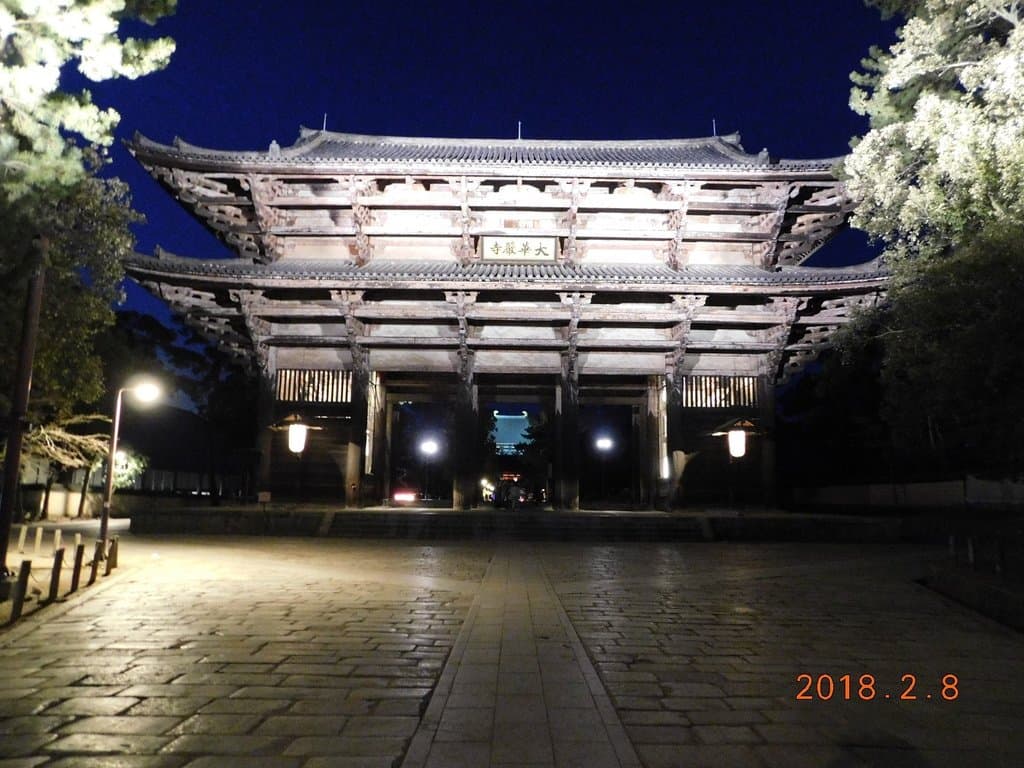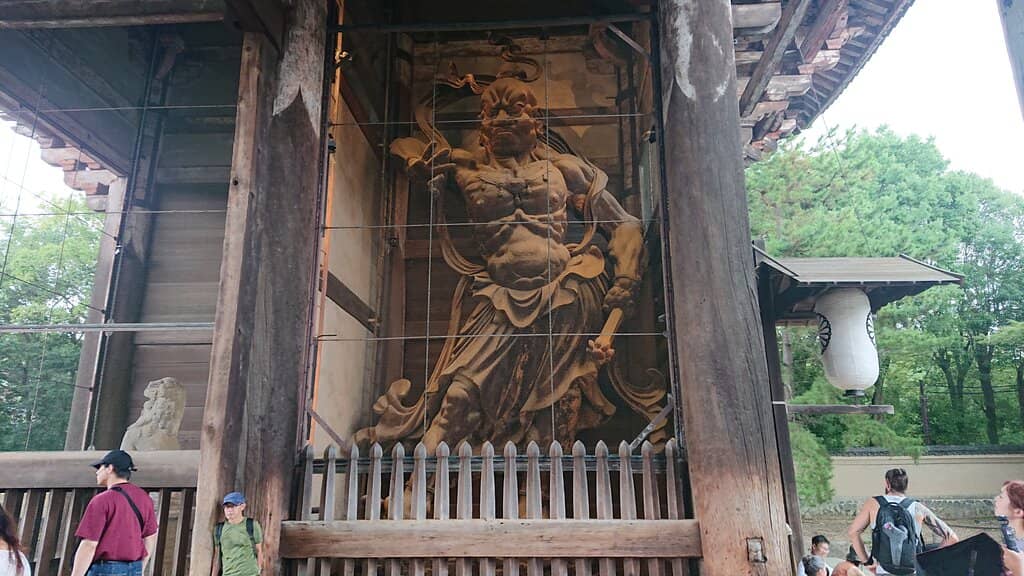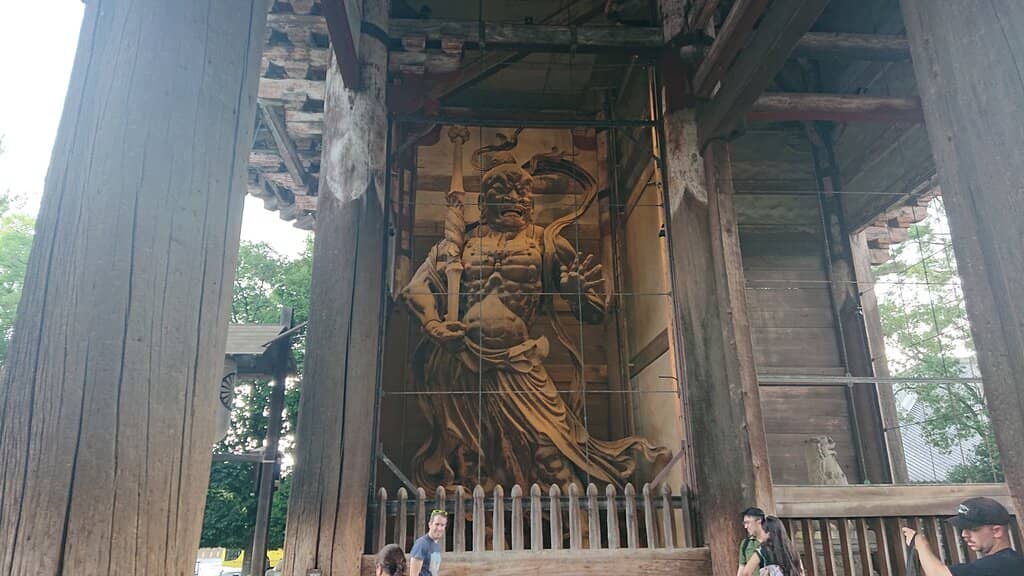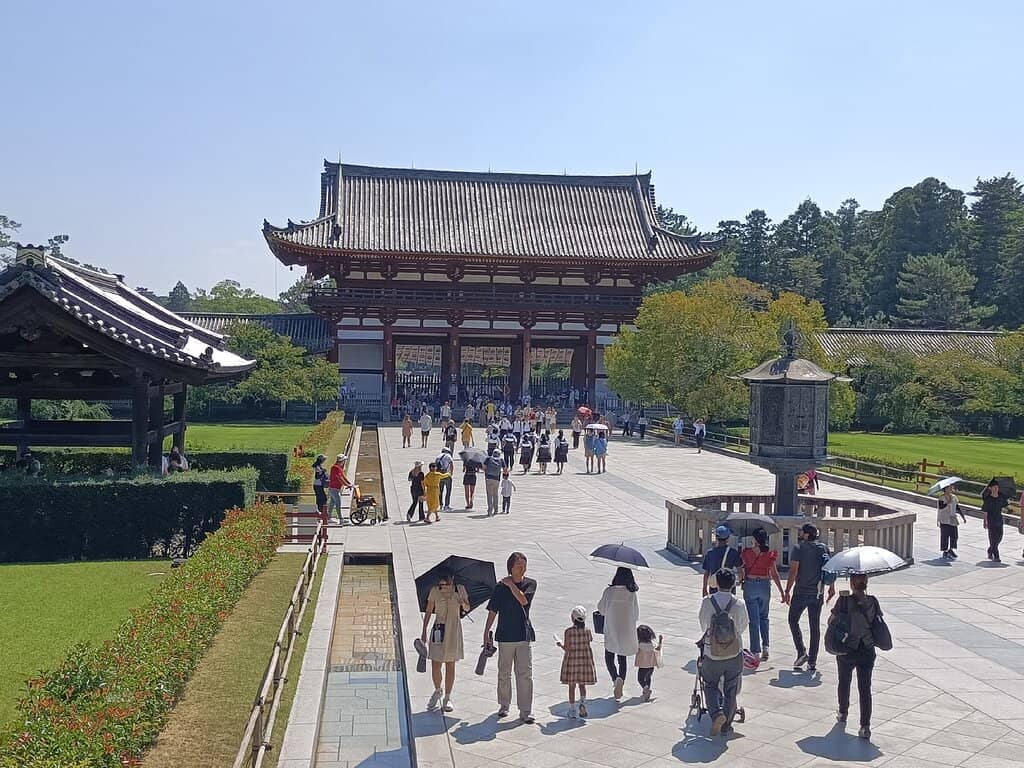
Nandaimon Gate Todai-ji
The colossal Nandaimon Gate, a 13th-century masterpiece guarding Todai-ji, features massive pillars and fierce Nio statues.

Highlights
Must-see attractions

Social
From TikTok & Reddit
Best Time
Peaceful atmosphere, no crowds

Nandaimon Gate Todai-ji
Best Time
Peaceful atmosphere, no crowds

Highlights
Must-see attractions
The colossal Nandaimon Gate, a 13th-century masterpiece guarding Todai-ji, features massive pillars and fierce Nio statues.
"An awe-inspiring entrance that sets the stage for an unforgettable experience at Todai-ji Temple."

🎯 Arrive Before the Crowds
Visit early morning for a serene experience and great photos without many people.
🦌 Deer Etiquette
The deer are friendly but can be persistent. Buy deer crackers if you want to feed them.

Highlights
Discover the most iconic attractions and experiences

The Grand South Gate (Nandaimon)
Entrance to Todai-ji Temple
Japan's largest temple entrance gate, a monumental 25m tall structure with eighteen giant pillars.

Guardian Nio Statues
Inside Nandaimon Gate
Two colossal, fierce wooden statues (over 8m tall) sculpted by Unkei and Kaikei, guarding the gate.

Massive Wooden Pillars
Nandaimon Gate
Eighteen enormous pillars, each measuring over 19 meters, supporting the impressive double-tier roof.
Plans like a pro.
Thinks like you
Planning Your Visit
Beat the Crowds for a Serene Experience
Combine with Nara Park Exploration
Best Times
Insider Tips
from TikTok, Instagram & Reddit
🎯 Arrive Before the Crowds
Visit early morning for a serene experience and great photos without many people.
🦌 Deer Etiquette
The deer are friendly but can be persistent. Buy deer crackers if you want to feed them.
Is Nara worth it for a day trip?
Nara
📸 Capture the Scale
Stand close to the pillars to truly appreciate the immense size of the gate and statues.
🚶♂️ Walk Through History
Take your time to absorb the atmosphere; it feels like stepping back in time.
Visiting Nara
Tips
from all over the internet
🎯 Arrive Before the Crowds
Visit early morning for a serene experience and great photos without many people.
🦌 Deer Etiquette
The deer are friendly but can be persistent. Buy deer crackers if you want to feed them.
📸 Capture the Scale
Stand close to the pillars to truly appreciate the immense size of the gate and statues.
🚶♂️ Walk Through History
Take your time to absorb the atmosphere; it feels like stepping back in time.
What Travellers Say
Reviews Summary
Visitors are consistently awestruck by the sheer scale and historical grandeur of Nandaimon Gate, often highlighting the impressive Nio guardian statues and massive pillars. Many recommend an early morning visit to avoid crowds and enjoy a more peaceful experience. While the gate itself is free to view, the associated ticket for Todai-ji's main hall can lead to queues during peak times.
"The Great South Gate is the main gate of Tōdai-ji. The original, erected during the Nara period, was destroyed by a typhoon during the Heian period. The present structure, which dates to the Kamakura period, was built using what is known as the “Daibutsu style.” A type of construction based upon Sung Chinese models, it was newly introduced to Japan by Chōgen, the monk responsible for restoring Tōdai-ji, at the end of the twelfth century. The ridgepole was raised in 1199 and the structure was completed in 1203 along with the statues of the guardian dieties, the Two Ni-ō housed in the gate. The gate with its double hip-and-gable roof is five bays wide and two bays deep. Originally there were three pairs of doors. The eighteen giant pillars that support the roof measure 19.058 meters and the entire structure rises 25.46 meters above the stone plinth on which it rests. The Great South Gate is the largest temple entrance gate in Japan, suitable in scale to the Great Buddha Hall.
The two muscular guardians in the Great South Gate, commonly known as the “Ni-ō (Two Kings) of Tōdai-ji,” are monumental works said to have been sculpted in just sixty-nine days under the direction of the sculptors Unkei and Kaikei. Both statues measure just over 8.4 meters in height."
Soni Pratik
"We arrived at Tōdai-ji’s Nandaimon Gate around 6:30 AM, and it was wonderfully quiet with no crowds at all. The massive wooden gate looked even more impressive in the soft morning light. It felt peaceful and calm — a perfect time to enjoy the historic atmosphere.
A few kind local ladies were already sweeping up deer droppings, keeping the area clean. The deer were calm and not pushy at all. It was nice to take photos without people in the background, and we could really appreciate the size and beauty of the gate.
Highly recommended to come early if you want a quiet and relaxing experience before the tourists arrive."
MOHAMAD FARHAN MORMIN
"Peaceful, charming, and full of history!
Nara is an incredible place to visit, just a short trip from Kyoto. The highlight for me was definitely the friendly deer roaming freely around Nara Park – they bow to you and are so gentle! Todai-ji Temple is awe-inspiring, especially the giant Buddha statue inside. The whole town has a calm and relaxing atmosphere with beautiful nature and well-preserved historical sites. It’s perfect for a day trip. Don’t forget to try some local snacks and buy deer cookies to feed the deer. A unique and unforgettable experience!"
バラ
What People Like
What People Dislike
Frequently Asked Questions
🚇 🗺️ Getting There
Nandaimon Gate is the main entrance to Todai-ji Temple. From Nara Station (JR or Kintetsu), it's about a 20-minute walk through Nara Park, or you can take a local bus to the Todai-ji Daibutsuden stop.
Yes, it's very accessible. Buses run frequently from Nara Station to the Todai-ji area, making it convenient for visitors.
Take a JR Nara Line train from Kyoto Station to Nara Station (approx. 45 minutes), then walk or take a bus.
There are parking lots available near Todai-ji Temple, but it's often easier and more pleasant to use public transport and enjoy the walk through Nara Park.
Nandaimon Gate is the primary and most impressive entrance to Todai-ji Temple complex.
🎫 🎫 Tickets & Entry
Nandaimon Gate itself is generally accessible without a separate ticket as it's the entrance to the Todai-ji Temple grounds. However, to enter the Great Buddha Hall (Daibutsuden) behind it, you will need an admission ticket.
Nandaimon Gate is part of the Todai-ji Temple complex, which typically opens around 8:00 AM and closes between 4:30 PM and 5:30 PM depending on the season.
Entry to the Nandaimon Gate area is usually free. The fee applies to enter the main temple buildings, like the Great Buddha Hall.
While online ticket purchasing might be available for some attractions, it's often straightforward to buy tickets on-site at Todai-ji. Be prepared for queues during peak times.
Currently, there isn't a widely advertised combined ticket for Todai-ji and other major Nara attractions. Tickets are usually purchased individually for each site.
📸 📸 Photography
Yes, photography is generally allowed at Nandaimon Gate and the surrounding grounds. However, flash photography might be restricted inside the temple buildings.
The best photos are often taken from a distance, capturing the entire gate with its pillars, or up close to highlight the intricate details of the Nio statues. Early morning light is ideal.
Yes, you can take photos of the Nio statues from the designated viewing areas within the gate.
Drone photography is strictly prohibited in and around temple complexes in Japan, including Todai-ji, for safety and preservation reasons.
Early morning, just after opening, offers soft light and fewer people, making it perfect for capturing the gate's grandeur without distractions.
🎫 🦌 Nara Park Deer
The deer in Nara Park, including those near Nandaimon Gate, are generally very friendly and accustomed to people. They may bow for treats!
Deer crackers ('shika senbei') are sold by vendors throughout Nara Park, often near the main attractions like Nandaimon Gate and Todai-ji.
While generally gentle, the deer can become quite eager for crackers. It's best to keep your food secure and avoid provoking them.
You can pet the deer, but be mindful of their behavior. Some may be more receptive than others.
The main rule is to feed them only the official deer crackers. Avoid feeding them human food, and be respectful of their space.
For Different Travelers
Tailored advice for your travel style
👨👩👧 Families with Kids
The sheer size of the Nandaimon Gate and its guardian statues is impressive for all ages, sparking curiosity about history and mythology. The walk through Nara Park to reach the gate is also pleasant, with plenty of space for children to move around. Consider bringing a stroller for younger children, as there's a fair bit of walking involved.
🚶♂️ Solo Travelers
Nara is a very walkable city, and the journey through Nara Park to the gate is a pleasant solo adventure. You can take your time to capture photos, observe the deer, and soak in the atmosphere without feeling rushed. The friendly nature of the deer also makes for some charming interactions.
📸 Photographers
Experiment with different angles: get low to emphasize the height of the pillars, or stand back to frame the entire gate with the sky. The Nio statues offer incredible detail for close-up shots. Remember to be respectful of other visitors and avoid blocking pathways while you're composing your shots.
Deep Dives
In-depth insights and expert knowledge
The Architectural Marvel of Nandaimon
The sheer scale of the Nandaimon is designed to awe visitors, setting a reverent tone before entering the sacred grounds of Todai-ji. The construction techniques employed were revolutionary for their time, showcasing a deep understanding of structural integrity and aesthetic balance. Walking beneath its archway provides a tangible connection to centuries of history and devotion.
Beyond its structural brilliance, the gate is a masterpiece of artistic expression. The intricate joinery and the sheer volume of timber used are a visual spectacle. It stands not just as a functional entrance but as a monumental work of art that embodies the spirit and ambition of the Kamakura period.
The Fearsome Nio Guardians
The Nio statues are divided into two types: the 'Agyo' (on the right, with mouth open) and the 'Ungyo' (on the left, with mouth closed). The open mouth of the Agyo statue represents the beginning of all things, while the closed mouth of the Ungyo statue symbolizes the end. Together, they represent the cycle of life and the protective power of the Buddhist faith.
These statues are not merely decorative; they are powerful symbols of strength and vigilance. Their detailed carving and dynamic poses convey a sense of raw power and spiritual authority, making them a focal point of admiration for visitors. The artistry involved in their creation highlights the skill and dedication of the sculptors and the importance placed on protecting sacred sites.






Social
from TikTok, Instagram & Reddit